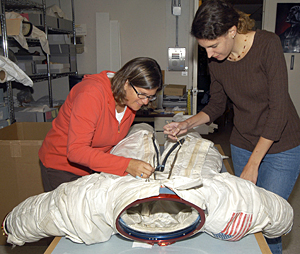
- UD grad interns help preserve mummies, spacesuit, other cultural treasures
- Bringing a saintly portrait back to life in Missouri
- Conserving a knight's shield from ages past
- Käsebier photographs conserved at National Gallery of Canada
- Examining ancient Egyptian mummies at the Walters Art Museum
- Restoring Southwestern pottery at the Arizona State Museum
- Caring for Maryland's first settlement, Armstrong's spacesuit
- Preserving masterpieces at the Walters Art Museum
- 'Big Four' railroad magnate's paintings undergo conservation at Yale
- Studying indigo dyes at the Smithsonian
- Treating a Moorish Islamic ceiling at the Metropolitan Museum of Art
Editor's note: The Winterthur/University of Delaware Program in Art Conservation is one of only five graduate-level conservation programs in the United States. Graduate students in the program spend their third year in an advanced internship at museums and studios around the world.
Here, Sharon Norquest reports on her work at Alexandria Conservation Services.
10:17 a.m., March 19, 2009----During the fall semester, I completed an internship at Alexandria Conservation Services (ACS), located in Alexandria, Virginia, under the supervision of Lisa Young. My work was mostly concentrated on the treatment and stabilization of metal artifacts from Historic St. Mary's City. Funding for the treatment of these objects was provided by an Institute of Museum and Library Services grant.
Located in Maryland on the Chesapeake Bay, Historic St. Mary's City was founded in 1637 and was the first capital of Maryland. Archaeologists have uncovered numerous artifacts that provide valuable details about daily life in this early settlement. In September, a new exhibit opened at Historic St. Mary's City called St. John's Site that preserves the foundation and explains the features of the home that was built there in 1638 for Maryland's first provincial secretary.
I reconstructed a broken onion bottle that was recovered from this site and is now on display in the exhibit. Onion bottles are green glass bottles that are named for their shape, which resembles an onion. These short bottles had a wide base, which made them sturdy. They were used for transporting wine across the Atlantic Ocean.
In addition to this bottle, I treated many iron, copper and lead objects from many sites at Historic St. Mary's City. These metal objects were excavated within the past 40 years and were identified during a survey as being unstable and in need of conservation. Treatment of these objects included the removal of dirt and excess corrosion products, which helped to stabilize the objects and to identify features on the objects. It was very exciting to uncover makers' marks on copper objects and to uncover white metal decoration on iron objects during this cleaning.
The iron objects were coated with tannic acid, a corrosion inhibitor, and coated with B72, a moisture barrier that will protect the object from further corroding. All metal objects received this moisture barrier coating. This project has been a great opportunity to learn about the materials and objects that were used at an early American settlement.
I also had the opportunity to assist with the removal of a display mannequin from the spacesuit Neil Armstrong wore when he walked on the moon. The Smithsonian National Air and Space Museum recently removed the spacesuit from display in order to examine and care for it as needed. This was an incredible opportunity to assist with the care of Neil Armstrong's spacesuit and to see all of the spacesuits, helmets, and gloves stored at the Smithsonian National Air and Space Museum.


